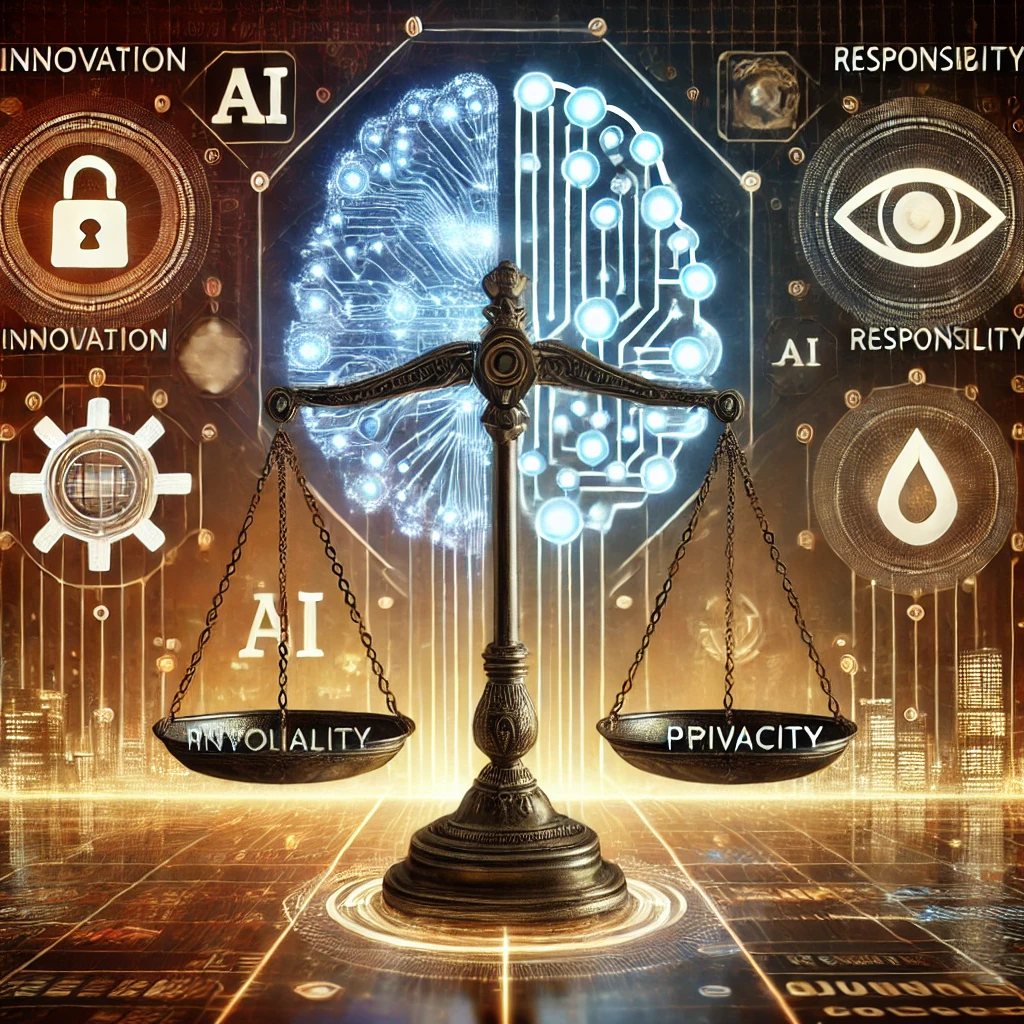Introduction
Artificial Intelligence (AI) is revolutionizing various sectors by processing large amounts of data, automating repetitive tasks, and even simulating human thought processes. However, as AI becomes more prevalent, it brings up significant ethical considerations. It is crucial to balance the pursuit of innovation with the imperative of responsibility to make sure AI benefits society in a fair and ethical manner.
Exploring AI Ethics
AI ethics examines the moral aspects involved in creating and using intelligent systems. Key ethical questions include:
- Fairness: How can we ensure AI systems are unbiased and fair?
- Accountability: Who is responsible for the decisions made by AI systems?
- Transparency: How can AI systems be made understandable to users and regulators?
- Privacy: How should AI manage sensitive personal information?
These principles help guide the development and implementation of AI technologies to reduce harm and increase societal benefits.
Ethical Challenges in AI Development
Bias and Discrimination
AI systems can inherit biases present in their training data. If the data reflect societal prejudices, AI may continue or even intensify these biases.
- Examples: Facial recognition software often struggles with identifying individuals with darker skin tones. Recruitment algorithms might favor certain demographics based on past hiring trends.
- Solution: Use diverse and representative datasets and implement techniques to detect and reduce bias.
Privacy and Surveillance
AI often relies on large datasets, which raises privacy and surveillance concerns.
- Examples: Social media platforms use AI to analyze user behavior, sometimes crossing ethical lines to target advertisements or influence content.
- Solution: Implement stricter data privacy regulations and clear consent mechanisms for users.
Job Displacement
AI’s ability to automate tasks can threaten jobs in various sectors, such as manufacturing and customer service.
- Examples: Chatbots taking over customer service roles or self-driving cars decreasing the need for drivers.
- Solution: Introduce policies that focus on retraining workers and creating new job opportunities in AI-related fields.
Lack of Accountability
Assigning responsibility for AI’s decisions can be challenging, particularly when errors or harm occur.
- Examples: Misdiagnoses by healthcare AI or accidents caused by autonomous vehicles.
- Solution: Develop clear legal frameworks to define accountability and liability.
The Role of Ethical Frameworks
Principles for Responsible AI
Organizations and governments have proposed guidelines to ensure AI is developed responsibly. Common principles include:
- Transparency: Ensuring AI systems are understandable and explainable.
- Fairness: Preventing discrimination and promoting equitable outcomes.
- Accountability: Defining responsibility for AI decisions.
- Privacy: Protecting personal data from misuse.
- Human-Centric Design: Ensuring AI serves the best interests of humanity.
Regulatory Initiatives
- EU AI Act: Seeks to create a legal framework prioritizing safety and fundamental rights in AI.
- OECD AI Principles: Promotes trustworthy AI development aligned with ethical values.
These frameworks establish standards for ethical AI practices globally.
Balancing Innovation with Responsibility
Encouraging Innovation
AI has the potential to drive significant advancements in areas like healthcare, education, and addressing climate change. Ethical considerations should guide innovation towards positive outcomes without stifling progress.
- Example: AI tools like DeepMind’s AlphaFold have transformed protein structure prediction, advancing medical research.
Conclusion
Balancing innovation and responsibility in AI is crucial for ensuring its benefits are distributed fairly and ethically. By addressing ethical challenges and adhering to established frameworks, we can harness AI’s potential while minimizing risks. # Ensuring Responsibility
Balancing Innovation and Responsibility
Inclusive Development
Engage a broad range of stakeholders, including ethicists, technologists, and impacted communities, in the AI development process.
Continuous Monitoring
Regularly evaluate AI systems for any unintended impacts and make updates as needed.
Ethical AI by Design
Incorporate ethical considerations from the beginning of the development process.
Real-World Examples of Ethical AI Use
Healthcare
AI enhances diagnostics and personalized treatment. For example, AI can accurately identify diseases like cancer from medical images. Ethical issues include maintaining data privacy and ensuring unbiased training data.
Criminal Justice
AI tools assist in predictive policing and sentencing. However, it is essential to monitor for racial and socioeconomic biases to ensure fairness.
Climate Change
AI aids environmental efforts by optimizing energy usage, monitoring deforestation, and forecasting natural disasters. Responsible use ensures these tools are inclusive and not abused.
The Future of Ethical AI
As AI progresses, the ethical landscape will grow more intricate. Future developments may involve:
AI for Social Good
Utilizing AI to tackle global issues like poverty and disaster response.
Collaborative Governance
Governments, businesses, and global organizations working together to establish universal ethical standards.
Human-AI Collaboration
Ensuring AI supports human decision-making instead of replacing it.
Creating sustainable AI systems that reflect human values while leveraging their transformative potential is crucial.
Practical Steps for Ethical AI Implementation
Education and Awareness
Educate developers, policymakers, and the public about AI ethics.
Diversity in AI Teams
Promote inclusivity in AI development to reduce bias.
Ethical Audits
Regularly assess AI systems for ethical compliance.
Transparency in Algorithms
Clarify and interpret AI decision-making processes.
Conclusion
The ethics of Artificial Intelligence is a critical area requiring ongoing attention as technology evolves. By emphasizing fairness, transparency, accountability, and privacy, society can harness AI’s transformative power while protecting human values. Balancing innovation with responsibility is not just a moral duty—it is vital for creating a future where AI is a force for good.
Navigating this complex landscape requires collaboration among governments, industries, and individuals to ensure AI remains a tool for progress, not harm.
